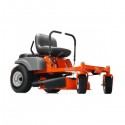Lawn Mower Buying Guide
These are the 10 best lawn mowers based on product quality, customer satisfaction, and price:
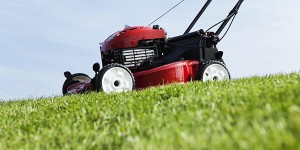 There is nothing that is quite so quintessentially American as the sound of lawn mowers starting up on the weekend.
There is nothing that is quite so quintessentially American as the sound of lawn mowers starting up on the weekend.
The smell of freshly cut grass is as much a part of suburban life on the weekend as cookouts and above ground pools are.
Keeping a well manicured lawn is the pride of every home owner, and there is a lot of work that goes into this task.
Watering regularly, seeding bald patches, and making sure to keep the lawn fertilized and well fed are all important aspects to maintaining a verdant, lustrous lawn.
But above all of these, of course, is keeping the grass properly cut and neatly edged.
In order to do this, you need the right kind of lawn mower. Not just any cheap machine will do: you want a lawn mower that can perform the task reliably and to your specifications. Beyond that, you need a lawn mower that will take as much work as possible out of the job of mowing the lawn.
There is nothing worse than sweating in the hot sun while you struggle with a lawn mower that is too heavy, or does not have the right blade, or does not have enough power to deal with thicker, tougher varieties of grass.
Conversely, with the right kind of lawn mower, cutting the grass can be a breeze. It turns a chore into an almost enjoyable task that you will look forward to each week. With a good lawn mower, you can be certain you are getting a clean cut every time and that you are treating your grass right. The lawn will respond to being correctly cared for by growing back even greener and more robust than it was before you cut it, and soon your lawn will be the envy of the neighborhood.
But there are a lot of different kinds of lawn mowers out there. How can you be sure you are shopping for the one that is right for your needs?
Well, on this site I have developed a comprehensive series of guides and reviews of different kinds and models of lawn mowers.
This series is designed to teach you everything you need to know about lawn mowers in order to be confident that you will choose the best one for your needs. Armed with the knowledge I provide here, you are going to be a very savvy shopper, and I guarantee you will know exactly what you need to know in order to pick out the perfect lawn mower for your landscaping and lawn care needs.
There are a number of things you have to consider about your lawn and mowing needs when you are shopping for a new lawn mower. By getting a good picture of these considerations, you will be well on your way to understanding what kind of lawn mower you need to keep your lawn in peak condition, optimal health, and looking beautiful all year round.
This guide is intended as a generalized introduction to lawn mowers.
Along with my extensive guides of specific kinds of lawn mowers, my detailed product reviews, and my charts showing detailed specifications for different manufacturers’ lawn mowers, I provide all the information you could want when you are shopping for a new mower.
I understand that this kind of major purchase can be a daunting one. Whenever you are planning to spend several hundred or even a thousand dollars on a new landscaping tool, you have to be careful, and with all of the options available today, it can be somewhat confusing as to what product is best for you.
But rest easy. My comprehensive series on lawn mowers will show you everything you need to know.
1. Choosing the Right Lawn Mower
1a. Property Size
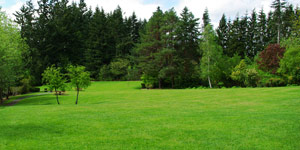 First and perhaps most importantly, you will have to consider the size of the property you will be taking care of.
First and perhaps most importantly, you will have to consider the size of the property you will be taking care of.
American yard size today can range from postage stamp lawns in urban backyards to suburban lots between 1/2 and a full acre or more to rural properties that are well over a single acre.
In addition, you have to consider what is on your property and the contours of its terrain. Do you have a single lawn that is level and open, with few trees or other obstacles? Is there a wooded lot on your property? Is the part of the backyard closest to the house a manicured lawn, and the area to the rear of the yard dotted with raised garden beds or other complex obstacles?
1b. Grass Type
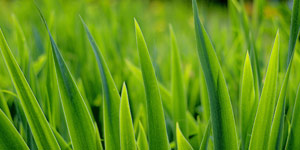 In addition to the size of the property and type of obstacles present, the kind of grass you have growing on it will also affect the kind of lawn mower you will want to purchase, specifically in terms of how much power you want your lawn mower to have.
In addition to the size of the property and type of obstacles present, the kind of grass you have growing on it will also affect the kind of lawn mower you will want to purchase, specifically in terms of how much power you want your lawn mower to have.
In the Southern United States and on the Atlantic coast, St. Augustine and Bermuda grass are popular varieties for lawns. These are adaptable to drought as well as very wet conditions, and stand up well to heat waves, all of which make them perfect for this climate. But they are also very thickly growing, tough grasses, which means a weaker lawn mower will have difficulty cutting through them.
In the Northern United States and Midwest, tall fescues and Kentucky bluegrass are more common varieties. These are not as drought tolerant, but they are a finer type of grass, which means they will be easier to cut with a less powerful machine. But they will also have a harder time recovering if they are cut too close to the ground.
1c. Cutting Height
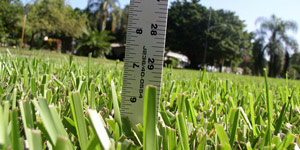 This brings up an important point to keep in mind when you are shopping for a new lawn mower. Lawn experts do not recommend cutting your grass any shorter than 1/3 its current height.
This brings up an important point to keep in mind when you are shopping for a new lawn mower. Lawn experts do not recommend cutting your grass any shorter than 1/3 its current height.
Doing so can severely damage the individual stalks of grass, making them more susceptible to disease and more likely to suffer from brown patches during heat waves or droughts. But because grass grows at variable rates depending on the weather, and besides that we do not always cut it on a regular schedule, you will not always want to be mowing your lawn at the same height.
So it is important to make sure you find a mower with several different height options that are easy to adjust.
1d. Deck Size
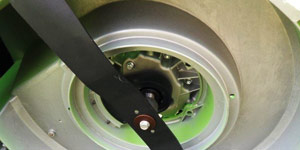 The next thing you will need to keep in mind when you are looking for a new mower is the deck size it has.
The next thing you will need to keep in mind when you are looking for a new mower is the deck size it has.
Deck size is a measurement of the width of the cutting swath the mower provides. Lawn mowers with a larger deck size cut a wider swath and therefore can finish cutting a lawn in fewer passes. Fewer passes means the job will take less time.
But on the other hand, a lawn mower that has a wider deck size but does not have the power necessary to support it may founder in thick grasses like the ones described above.
Also, a mower with a very wide deck size may be less maneuverable than smaller lawn mowers and have a harder time getting around obstacles on your property.
1e. Environment
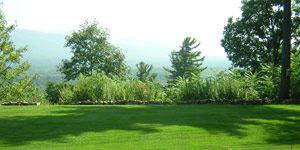 You will also have to consider whether you are more interested in having a lawn mower with a lot of power or one that has less power but also has a smaller impact on the environment.
You will also have to consider whether you are more interested in having a lawn mower with a lot of power or one that has less power but also has a smaller impact on the environment.
Gas mowers are able to power larger engines with more horsepower and torque than electric mowers, but they are also responsible for five percent of all carbon emissions in the United States, according to the EPA. In addition they spew out gas fumes and require you to store smelly gas cans and messy oil cans in your garage or tool shed.
Electric mowers, particularly those with an EPA Energy Star rating, have a much smaller impact on the environment, reduce your household’s carbon footprint, and also help you to save money you would otherwise be spending on gas, the prices of which are at an all time high. But at the same time, they may not have enough power to deal with very large lawns, especially if they are planted with thicker grasses like St. Augustine. They also will have a harder time with dense patches of grass or wet grass. So it is important to consider all of these factors when you are deciding which kind of mower to buy.
1f. Mower Type
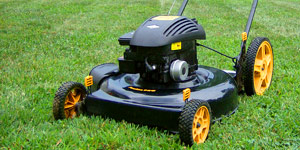 Lawn mowers today fall into one of two general categories: they are either walk behind mowers or riding mowers.
Lawn mowers today fall into one of two general categories: they are either walk behind mowers or riding mowers.
Walk behind mowers are, as the name suggests, maneuvered by an operator who walks behind the machine, guiding it over the lawn with a rear handle. They come in several different styles, as I will discuss below, and are generally best for homeowners with properties that have lawns that are a half acre or less in total area.
Riding mowers are self-propelled machines that the operator rides on while steering them around the lawn. They are considerably larger than walk behind mowers, and again have a number of different styles that are designed for different landscaping needs.
Riding mowers are typically designed for properties with lawns that are a half acre or more in size, and are also idea for landscaping professionals and rural property owners with large gardens or mini farms.
2. Lawn Mower Types
2a. Walk-Behind Mowers
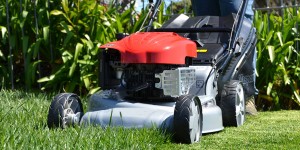 There are three general categories of walk behind mowers available on the market today. They include reel mowers, electric mowers, and gas mowers. Reel mowers, also called push mowers or manual mowers, are the only mechanical mowers in the group, and they are powered entirely by the operator’s own elbow grease. Reel mowers have a series of helical blades arranged in a cylinder around a central axis that is parallel to the ground. As the operator pushes the mower forward, gears attached to the wheels cause the blades to spin rapidly around the central axis. The blades force the grass against a rear cutting surface, where they are sliced off. The design of reel mowers allows them to provide the cleanest, least ragged cut to your lawn, which is beneficial both to its appearance but also its overall health. However they are not ideal for lawns that are more than a quarter of an acre at most, since they are entirely human powered.
There are three general categories of walk behind mowers available on the market today. They include reel mowers, electric mowers, and gas mowers. Reel mowers, also called push mowers or manual mowers, are the only mechanical mowers in the group, and they are powered entirely by the operator’s own elbow grease. Reel mowers have a series of helical blades arranged in a cylinder around a central axis that is parallel to the ground. As the operator pushes the mower forward, gears attached to the wheels cause the blades to spin rapidly around the central axis. The blades force the grass against a rear cutting surface, where they are sliced off. The design of reel mowers allows them to provide the cleanest, least ragged cut to your lawn, which is beneficial both to its appearance but also its overall health. However they are not ideal for lawns that are more than a quarter of an acre at most, since they are entirely human powered.
Electric and gas mowers are both rotary mowers. Rotary mowers have an engine that powers a blade that rotates parallel to the ground. As the blade spins, it slices the grass. Both gas and electric mowers can either fall into the push style category or the self propelled category. In the former, the engine only powers the cutting blade and the operator maneuvers the mower around the yard under their own power. In the latter category, the motor powers the cutting blade as well as a drive mechanism that moves the mower forward under its own power, leaving the operator to simply walk behind and steer it.
Walk behind mowers are by far the most common kind used by homeowners today, because most of us do not have enough property to warrant a larger mower. If you decide to opt for a walk behind mower, there are several things to keep in mind. First is which kind is right for you. As I mentioned earlier, there are trade offs for an electric versus a gas mower, and the same is true for a reel mower as well. Once you have that figured out, there are a number of other considerations as well, including deck size, grass management options (rear bag, side discharge or mulching), overall dimensions and weight and how these affect maneuverability and storage space, the runtime and area estimates for each type of mower, and how much you should plan on spending for each kind. In my guides of reel mowers, electric mowers, and gas mowers, I guide you through the different things you have to consider. And in my extensive product reviews and detailed breakdowns of the specifics of different manufacturers’ products, I help you understand the pros and cons of individual walk behind mowers.
2b. Riding Mowers
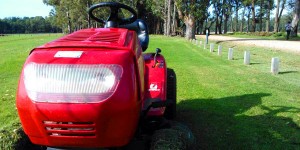 Riding mowers are designed for property owners who have more than a half an acre of grass to maintain, and frankly if your property is this large you almost have to own one in order to feasibly take care of it. Riding mowers offer two major advantages over walk behind mowers for maintaining large properties. The first is that you do not have to walk back and forth over an acre or more of grass while you are mowing it, which means you will not be worn out at the end of the job. The second is that riding mowers are able to support a much larger deck size than walk behind mowers. Riding mowers have deck sizes ranging from thirty to almost sixty inches in most cases – that is thirty to two hundred percent larger than the average walk behind mower. And many riding mowers come equipped with more than one cutting blade. That means they will be tough and durable, and able to attack large lawns week after week with minimal wear and tear on the machine.
Riding mowers are designed for property owners who have more than a half an acre of grass to maintain, and frankly if your property is this large you almost have to own one in order to feasibly take care of it. Riding mowers offer two major advantages over walk behind mowers for maintaining large properties. The first is that you do not have to walk back and forth over an acre or more of grass while you are mowing it, which means you will not be worn out at the end of the job. The second is that riding mowers are able to support a much larger deck size than walk behind mowers. Riding mowers have deck sizes ranging from thirty to almost sixty inches in most cases – that is thirty to two hundred percent larger than the average walk behind mower. And many riding mowers come equipped with more than one cutting blade. That means they will be tough and durable, and able to attack large lawns week after week with minimal wear and tear on the machine.
Riding mowers fall into one of two basic categories: lawn tractors and zero turn mowers. Lawn tractors are durable workhorses designed for the homeowner who has more than just grass cutting in mind. Lawn tractors fall into two categories as well: traditional lawn tractors and garden style lawn tractors. Traditional lawn tractors provide everything you need to take care of your lawn: in addition to wide cutting swaths and multiple grass clipping management options, they often are equipped with leaf collection accessories and spreaders for distributing fertilizer and grass feed.
Garden style lawn tractors kick it up a notch in the accessories department. They offer additional capabilities such as tow hitches for hauling loads of firewood, mulch, or manure around the garden, or pulling stumps and other debris out of the ground. They also have accessories available that can till the soil or dig furrows in it for planting crops or vegetables. Garden style lawn tractors are perfect for homeowners with large properties on which they have serious gardens or mini farms.
Zero turn riding mowers are hands down the most efficient machine for cutting the grass on large properties. These machines have a rear wheel drive with differential power controls. This means the operator can send more power to one wheel than the other. If both wheels receive the same amount of power, the mower moves in a straight line. If one wheel receives more power than the other, the mower travels in a curved line. And if one wheel is fully stopped or even moving backwards while the other receives forward power, the mower spins on its central axis. This kind of control allows for incredible maneuverability, which means you can easily drive around garden beds or trees on your property and get a cut that is so close you are practically using an edger.
Elsewhere on this site I provide a more detailed guide to what to look for in zero turn mowers as well as detailed breakdowns of the specifics for different manufacturers’ zero turn mowers. You can use these guides to get a full picture of what to look for when you are shopping for a zero turn mower.
These are the 10 best lawn mowers based on product quality, customer satisfaction, and price:

